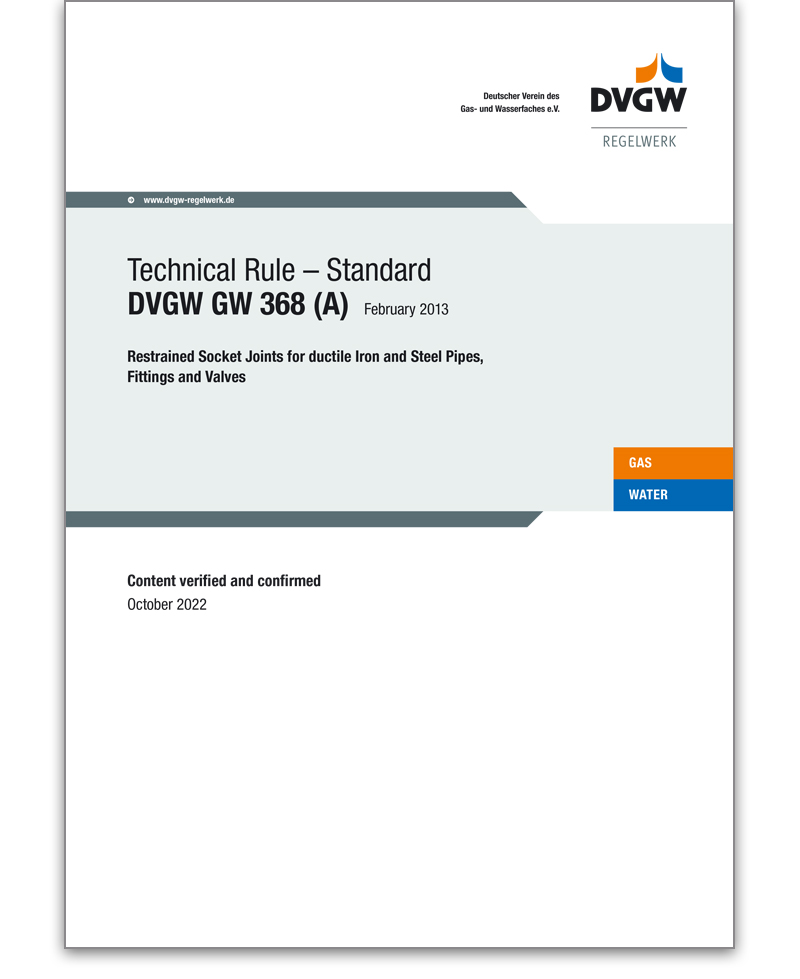GW 368 Standard 02/2013
Restrained Socket Joints for ductile Iron and Steel Pipes, Fittings and Valves ++ PDF file ++
- Format: 32 pages
- Material: available as PDF only
- Ausgabe: 3rd edition 2013
- Hinweis: German version GW 368
- Verkaufseinheit: 1
- Mindestabnahme: 1
- Artikel-Nr.: 510067
79,28 €*
The aim of this Standard GW 368 is to determine the lengths of pipeline to be locked against longitudinal forces.The Worksheet applies to ductile cast iron and steel pipes, fittings and valves. In principle, the formulaic correspondences described can also be applied to pipes in other materials. However, the properties of the other materials must be taken into account in each case, particularly specific weight and friction coefficient.
1 Scope
2 Normative references
3 Principles for design and calculation
3.1 General
3.2 Calculation of the pipeline lengths to be secured
3.3 Pipelines in groundwater and particular types of soil
4 Restrained push-in joints and advice on their use
Annex A (for information) ? Calculation of lengths to be secured
A.1 Forces on the pipeline
A.1.1 Thrust forces due to internal pressure
A.1.2 Soil resistance
A.1.3 Friction forces
A.1.3.1 General
A.1.3.2 Friction forces from the weight of the soil
A.1.3.3 Friction forces from the weight of the soil, water filling and pipe weight on the bottom of the pipe
A.1.3.4 Friction forces from soil resistance
A.1.3.5 Combination of friction forces
A.1.4 Interaction of thrust forces and soil resistance
A.1.5 Equilibrium of forces on the bend
A.1.5.1 Pipes in ductile cast iron
A.1.5.2 Steel pipes
A.2 Friction coefficient and soil pressure
A.3 Note on the tables in Annex B and Annex C
Annex B (for information) ? Minimum lengths of pipeline to be secured in m for ductile cast iron pipes to DIN EN 545 (drinking water pipelines)
Annex C (for information) ? Minimum lengths of pipeline to be secured in m for steel pipes to DIN 2460 (drinking water pipelines drinking water pipelines)
2 Normative references
3 Principles for design and calculation
3.1 General
3.2 Calculation of the pipeline lengths to be secured
3.3 Pipelines in groundwater and particular types of soil
4 Restrained push-in joints and advice on their use
Annex A (for information) ? Calculation of lengths to be secured
A.1 Forces on the pipeline
A.1.1 Thrust forces due to internal pressure
A.1.2 Soil resistance
A.1.3 Friction forces
A.1.3.1 General
A.1.3.2 Friction forces from the weight of the soil
A.1.3.3 Friction forces from the weight of the soil, water filling and pipe weight on the bottom of the pipe
A.1.3.4 Friction forces from soil resistance
A.1.3.5 Combination of friction forces
A.1.4 Interaction of thrust forces and soil resistance
A.1.5 Equilibrium of forces on the bend
A.1.5.1 Pipes in ductile cast iron
A.1.5.2 Steel pipes
A.2 Friction coefficient and soil pressure
A.3 Note on the tables in Annex B and Annex C
Annex B (for information) ? Minimum lengths of pipeline to be secured in m for ductile cast iron pipes to DIN EN 545 (drinking water pipelines)
Annex C (for information) ? Minimum lengths of pipeline to be secured in m for steel pipes to DIN 2460 (drinking water pipelines drinking water pipelines)

